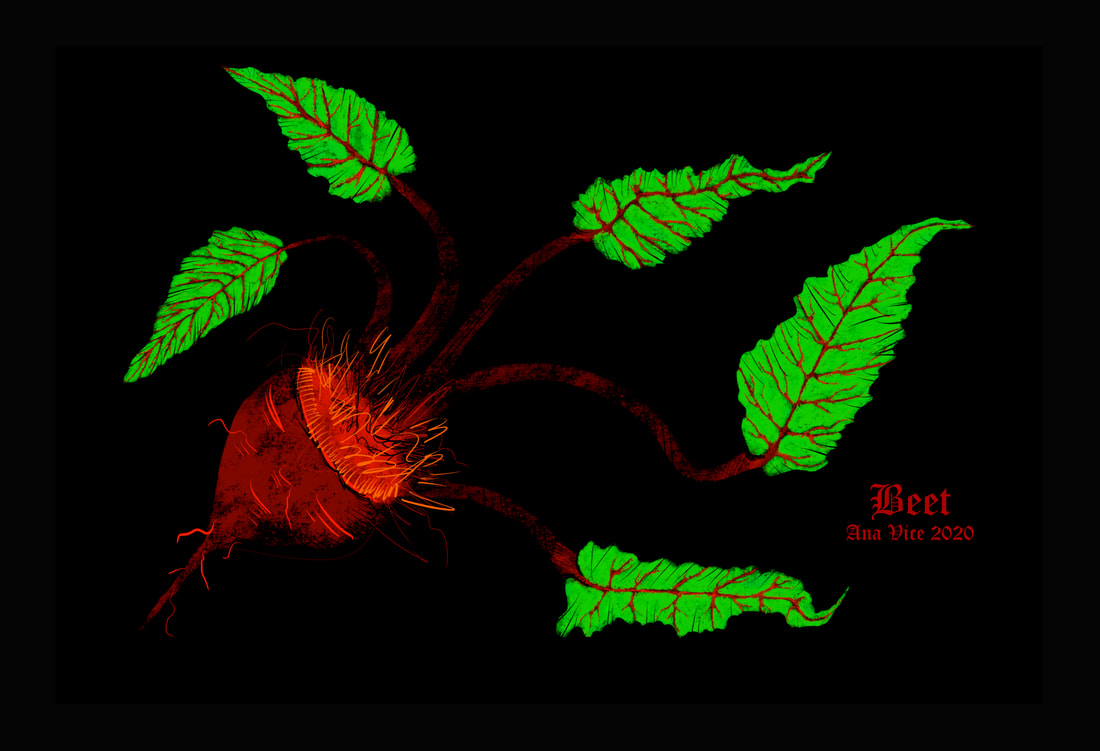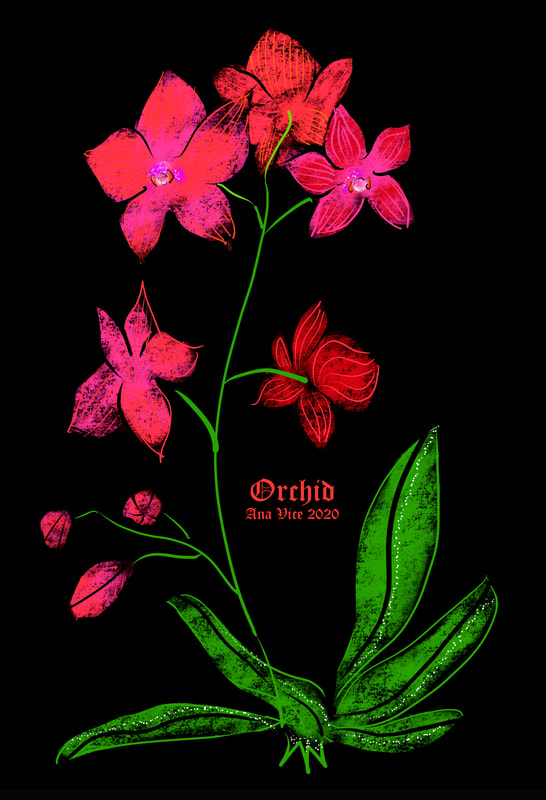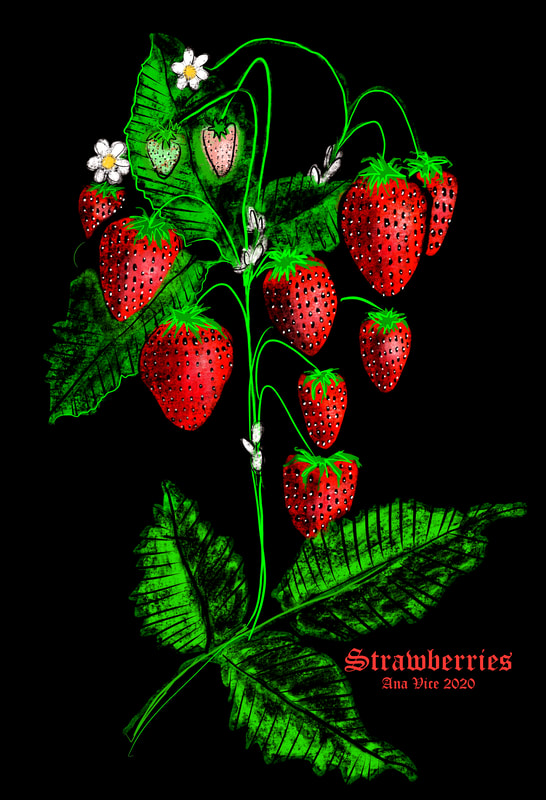|
By Ana Vice Need a touch of magick in your love life? There are all kinds of ways to use herbs with magickal intent: You can add them to oils, incenses, baths, ointments, lotions, soaps, perfumes, teas, tinctures, elixirs, pillows, poppets, and more. While Enchantments’ herbs aren’t for ingestion, it’s still important to clearly label your herbs, handle them with care, and separate those that may be poisonous to humans and animals (for example, morning glory and saffron are toxic to cats and dogs). The majority of herbs in this article are non-toxic, but still intended for spiritual and magickal use only. Many of you may already have some of these in your home apothecary or cabinet, but others you can buy at the grocery store, farmers market, or at the Enchantments shop, which has a botanica containing over 150 herbs. Here we share the beautiful folklore behind these ten "love" herbs, as well as their spiritual uses and connotations. Sugarcane (Saccharum officinarum) Sugarcane (sometimes known as Ko in Hawaii) is associated with the planet Venus and water element. Sugar in general has long been used in love and lust potions or magickal formuli. Some believe chewing on a piece of sugarcane whilst thinking of your loved one attracts them in a loving way. Sugar can also be used to “sweeten” someone to favor you or as an offering. Yemayá’s (one of the main Orishas in Santeria) favorite foods are watermelon and sugarcane syrup. As the mother of all living things and ruler over motherhood, she owns all the waters of the Earth and gave birth to the stars, moon, sun, and most of the Orishas. Yemaya’s aché is nurturing, protective and includes fertility. Yemayá is also a fierce warrior that protects her children from harm. Yemayá can be found in all the waters of the world and because of this she has many aspects of “caminos” (roads). She, like Oshún, carries all of the experiences of womanhood within her caminos. In the Philippines there is a myth about a sad chieftain. He was experiencing ennui despite the fact that he did so much for his tribe as a youth. He no longer found meaning in all his success and wondered what heaven might be like. One day he was making a prayer to Bathala (Creator God) to let Bathala know how fed up and bored he had become. According to the Tagalog, Bathala is the supreme deity who created the universe. The chieftain wished to end life on Earth and go to Heaven. Abruptly, a voice said that his time on earth was not done. Disappointed, the chieftain left his palace to go walk through the forest. There, he came across an old man who tried to cheer him up by saying that he could find heaven here on earth. The old man led the chieftain to a sugarcane plant and said that its sweet stem will take him to heaven. The chieftain began to chew the stem of sugarcane and was delighted by its sweetness. Sugarcane allowed the chieftain to realize that it’s the simple things in life that bring us joy. Witchy Tip: If you already work with Yemayá and want to conceive a child, you can use sugarcane syrup as an offering to her. Set your intention for fertility and the ability to conceive a healthy child. Light white and blue candles, and consider additional offerings of seven white flowers, cowries, or silver coins. Because she is the Great Ocean Mother, rituals at the beach are also an option. Beet (Beta vulgaris) Also known as mangel and mangold, beet is often associated with the planet Saturn, earth element, and love (it has been said that if two people eat from the same beet they will fall in love). Beet juice can be consumed as a beverage, but also used as an ink in love magick. For the Greeks, the Goddess Aphrodite symbolizes beauty, sensuality, love, and desire. One of her secret pleasures was said to be beetroot (aka pantzaria). It was believed that beets could make someone healthier and more beautiful, in addition to being an aphrodisiac. Records show that Greeks began cultivating beetroot around 300 BCE and they ate the leaves and used roots as offerings to Apollo (God of Sun and Light, and also one of Aphrodite’s lovers) in the temple of Delphi. The Greeks considered it to be worth its weight in silver, and Hippocrates may have even used beetroot leaves for binding and dressing wounds, as well as for medicine. Evidence of humans using beets dates back to the Neolithic site of Aartswoud in the Netherlands. Beets were associated with the Saqqara pyramid at Thebes, Egypt, which dates to the time of the Third Dynasty circa 2600 BCE. There were also Assyrian texts that describe beetroots growing in the Hanging Gardens of Babylon in 800 BCE. Romans consumed beetroots, but mainly for medicinal purposes (namely as a laxative or to cure fever). Apicius, an ancient Roman gourmet, wrote a book called The Art of Cooking and some of his recipes contained beetroots, including broths and salad dressings made of mustard, oil, and vinegar. Ranging in orange, yellow, or red in coloring, Celtic women have been known to use beetroot for lipstick and blush. Witchy Tip: Buy a good sized red beet at your local farmers market. Clean and carve your first name and astrological sign, then place the beetroot in a bowl and set your intention to attract love. Soaking the beet beforehand in warm water will yield a red water that can be used as ink if you wish to write out your intention. Lavender (Lavendula officinale or L. vera) Lavender (also known as elf leaf, nard, nardus, and spike) is associated with the planet Mercury and air element. Its spiritual attributes are protection, purification, sleep, chastity, love, happiness, and peace. Lavender is often used in sachets, pillows, baths, soaps, perfume, oils, poppets, and/or added to incense. Its fragrant flowers can be put into dresser drawers to scent clothing (especially to attract love) or the flowers can be burned to promote calm and restful sleep. A piece of paper on which you’ve rubbed lavender is excellent for writing love letters. It has also been used as a substitution for rice as wedding confetti. Lavender used to be worn by “ladies of the night” to attract customers and let people know they were available. Despite love associations with lavender, during the Renaissance it was thought that the combination of rosemary and lavender could keep a woman’s chastity. Ancient Egyptians, Phoenicians and Arabians used lavender as a perfume to attract love, too. While the Egyptians mummified their dead in lavender-dipped shrouds, Cleopatra apparently used lavender in her to seduce her lovers. Some say the energy of this plant is so strong that it can lift melancholy at the mere sight of it and bring in happiness. It’s often used in healing blends and purification baths. Some believe if you carry it with you to a place where there are ghosts or spirits that you’ll have the ability to see them. It can also be protective and ward off the evil eye. Witchy Tip: Make a small pillow and stuff it with lavender. Place it under your pillow at night. Before falling into a peaceful sleep free of bad dreams make a wish or set an intention for one or more of the following: love, happiness, protection, longevity, or peace. Morning Glory (Ipomoea spp.) Poison Often associated with the planet Saturn and water element, morning glory (aka bindweed) can promote happiness and peace. Try placing its seeds beneath your pillow or within a sachet to prevent bad dreams. You can make blended oils with it or add essential oil to incense blends and baths. Morning glory flowers bloom and die within one day. The Japanese were the first to cultivate morning glory (Asagao) as decorative flowers in the 800s AD. Asa means morning and kao is face, and the flowers were often used at japanese weddings. Most morning glory species bloom in the morning and start curling up a few hours before nighttime. They require full sun exposure and mesic soils to grow well. Morning glory flowers have a short lifespan, so sometimes it can be associated with the fleeting nature of love. But since it also gives birth to new flowers in the morning, it can signify the renewable nature of affection. In the Victorian symbolism of flowers, morning glory represents love in vain, and morning glory vines were often placed on headstones to symbolize mourning, a short life span, or even resurrection. According to the Chinese folklore, the star-shape of the flower signifies the day when the Chinese lovers Chien Niu and Chih Neu are permitted to meet for a single day each year. According to this story, the young boy Chien Niu was given the responsibility to take care of the water buffalos and the girl, Chih Neu, was entrusted with the task of sewing dresses. They fell deeply in love and eventually started ignoring their duties. This angered their God so much that they were separated on opposite sides of a silent river. Only once a year they were allowed to meet. Since the morning glory has such a short lifespan and ephemeral nature, it is befitting to symbolize the short-lived union between these young lovers. During the Aztec civilization, people utilized the juice of some morning glory species to form a rubber-like substance. They also mixed the seeds with tobacco and insects to slather on their bodies before performing ritualistic human sacrifice in order to dull the pain. It was believed that morning glory would help the victim to travel to the afterlife and be reborn. Aztec shamans are also said to have used the seeds in order to have visions and communicate with their gods. Morning glories inspired Louisa May Allcott to write Morning Glories and Other Stories and later Georgia O’Keeffe to paint Blue Morning Glories and Ram's Head, Blue Morning Glory in 1938. Witchy Tip: Make a small pillow out of blue cloth and stuff with morning glories to place under your head or pillow at night to get rid of nightmares and maintain a happy, peaceful slumber. Catnip (Nepeta cataria) Catnip (aka cat, catmint, field balm, and nip) is associated with the planet Venus and water element. Its spiritual and magickal attributes are love, beauty, joy, and happiness. Used in love or cat magick, it can be used as an offering to Bast or Bastet – the Egyptian goddess associated with protection, cats, perfumes, fertility, children, music, joy, the arts, and warfare. Growing catnip in your garden or hanging it over your front door it is thought to attract good spirits. Catnip has been used in traditional European medicine for hundreds of years. It was first mentioned the De viribus herbarum and valued for its ability to calm anxiety and act as a sleep aid. Furthermore, it was applied externally as a poultice to reduce swelling. Catnip can also be made into a juice to use for topical application, as was the practice by Nicholas Culpepper (a 17th century botanist, avid astrologer, physician, and herbalist). Mainly the flowering tops are used (dried for tea or fresh for an essential oil), but there are accounts of the root being used, too. Catnip is part of American folk medicine and has been used by The Hoh, Delaware, Cherokee, and Iroquois Native American tribes to make a gentle tea for children to help an upset stomach or with trouble falling asleep. The Cherokee also used catnip to make a strengthening tonic. In the southwestern United States, catnip (a.k.a. nebada in Spanish) was sold as a brandy infusion with fennel in a digestive tonic. Europeans used it as a remedy for digestive upset, as well. Witchy Tip: Put catnip and rose petals into a pink or red sachet bag to invoke love. Patchouli (Pogostemon cablin or P. patchouli) Patchouli (also known as pucha-pot and kablin) is associated with the planet Saturn, earth element, love, lust, fertility, and money. Patchouli has a strong earthy, musky scent and is often used for love or lustful magickal formulas (including fertility talismans), or money and prosperity spells. Patchouli can be made into a floor wash, incense, soap, or used in place of graveyard dust. A member of the mint family and covered in purplish-white flowers, the most commonly used portions of the plant are the dried leaves. When grown, the patchouli bush can reach nearly three feet tall. Patchouli comes from Southeast Asia and has a long history as an essential oil and folk remedy for skin ailments and anti-aging. Patchouli comes from the Hindui word pacholi meaning “to scent,” and East Indian shawls and fabrics were scented with patchouli oil in the 1800s. Both patchouli oil and incense underwent a surge in popularity in the 1960s and ‘70s in the US and Europe, mainly as a result of the hippie movement of those decades. In the 1980s it was a scent sometimes worn by Goths in the Gothic underground movement. Some believe that patchouli dispels negativity and promotes good dreams, in addition to attracting love. With its feminine, yet masculine characteristics, patchouli is associated with the deities Aphrodite and Pan. Patchouli is synonymous with passion and putting dried patchouli into small sleep pillows or sachets may promote an amorous atmosphere. The deep and lusty scent might entice your lover to feel romantic, especially since it’s a well-known aphrodisiac. To attract someone you desire, wear patchouli oil or place some patchouli root in a mojo bag to carry in your pocket or to wear around your neck. Witchy tip 5: Take a dram (1/6th of an ounce) of patchouli essential oil and make a spray with it. Spray yourself, your clothing, your wallet and anything else you desire to attract love and prosperity into your life. You can also anoint a green or pink votive candle with patchouli essential oil (3-6 drops) and set your intention for drawing either love or money. Orchids (Orchis spp.) Orchids (aka levant salap, sahlab, saloop, and satyrion) are associated with the planet Venus and water element. Used in love spells, especially the root, orchids can be carried in sachets or sewn into clothing. Some variations of orchids are used in inducing visions, trance-states, and for heightening psychic powers. Orchids, which come in a variety of colors, patterns, and shapes, are both captivating and inspiring. These exotic plants have made their way around the world and are often associated with love, fertility, and sensuality. One of the major orchid genera is Paphiopedilum (a.k.a. Venus Slipper and Venus is the Roman equivalent of Aphrodite). The name is derived from the word “Paphos” which is also the name of the Sanctuary of Aphrodite at Paphia, where the Greek Goddess of love was worshiped. In Ancient Greece, it was believed that parents could choose the sex of their child by eating the orchid’s tubers: If the father ate thick, fleshier tubers, the child would turn out to be a boy. If the mother ate smaller, thinner tubers, the child would turn out to be a girl. The orchid receives its name from a Greek myth: The young minor god Orchis is a little too young to be taken with one of Bacchus’ (the Greek God of wine) priestesses. Predictably, Bacchus has a wild response for this behaviour and little Orchis is divided across the land, a wild Orchid growing wherever a piece fell. This legend, retold across Europe as the Greek & Roman cultures collided, gives the orchid a passionate, fertile status. Indeed, the final piece of Orchis landed in the sea and some say led to the birth of Aphrodite. Native to Asia and the Mediterranean, the orchid’s role in China begins with over 2,000 years of cultivation and cultural importance. In China, orchids are regarded as emblems of integrity, elegance and friendship. Depictions of the distinctive flower in art and literature are common. Confucius believed the orchid to be a symbol of nobility and strength that should be valued. Aztecs commonly mixed vanilla, orchids, and chocolate to create an elixir that brought on power and strength. Witchy Tip: Create an Aphrodite love drawing sachet from fabric (preferably a pink, green, copper, or combination thereof) and fill with orchids + a petition or folded letter of intention. Carry it with you. Rose (Rosa spp.) Associated with the planet Venus and water element, rose can be used to enhance psychic powers, love divination, and invoke healing, luck, and protection. Petals and rose hips are often used for love magic, in addition to essential oil. A garland of roses can be worn when performing love spells or a single rose in a vase placed on an altar can aid in love-magick spellwork. Rose water made from rose petals can be added to love baths (i.e. self love and love attraction) and petals can be used to stuff a love poppet or sachet. It has been said that in order to discover their romantic future, women would make tea with green rose leaves and name each for one of their lovers. The one that remains green the longest corresponds to the love that will be true and lasting. Symbols for the Greek Goddess of Love, Aphrodite, include roses, doves, myrtles, sparrows, and swans. In modern times, the red rose is still associated with love. In the epic poem The Illiad, Homer tells us how Hector’s body was anointed with rose oil after his death at Achilles hand. According to the poet Anacreon, seafoam dripping from the body of Aphrodite as she is born turns into white roses representing her purity and innocence. Later, when she is trying to help her wounded lover, Adonis, Aphrodite sheds a few drops of blood onto a white rose and changes it to red representing her desire and passion. Another well-known Greek story is about the marriage of Eros (the God of Love and Sexual Desire) and Psyche (a mortal woman who became Goddess of the Soul aka Breath of Life). At their wedding ceremony, Zeus’s daughters (sometimes referred to as either the Horae or the three Gratiae aka Graces or Charities) covered the land in roses. Outside of Greek mythology, roses symbolize purity and sometimes motherly love. For Catholics, roses are often associated with the Virgin Mary and with activity of God or of a Saint in association to Our Lady of Guadalupe. A man named Juan Diego believed that he was given a sign by the Virgin Mary to bring the bishop to town and establish a church in her honor at the Hill of Tepeyac (Mexico City). He was told by Mary to go to the top of the hill to cut all the roses he found blooming there and place them in his cloak. Juan was a faithful man and went up the hill as he was asked. To his surprise he found a rose bush full of beautiful and fragrant roses at the top of the hill. He gathered them and brought them to the bishop as was requested by Mary. Upon seeing the bishop, Juan opened his cloak and the many beautiful roses fell out revealing a vivid image of Blessed Mary on the fabric of Juan’s cloak. Considered a miracle, the bishop agreed to build the church for Mary on the hill. Ultimately, the Feast of Our Lady of Guadalupe was established and celebrated each year on December 12. Witchy Tip: Draw yourself a hot bath, fill with rose petals, a few spoonfuls of sea salt, and several drops of essential rose oil. As you enter the bath allow all distractions of the day to fade. Seat yourself and take in the rose fragrance. Meditate or set an intention for self love or love attraction. Make robust petition to a Goddess of Love (such as Aphrodite or Venus). Otherwise, contemplate all that is love and let it wash over you as you take your bath. Feel the warmth and joy in this process. If you want, burn pink candles or play music to set the mood. Saffron (Crocus saliva) Also known as autumn crocus, krokos, kunkuma (Sanskrit), and saffer (Arabic), saffron is associated with the Sun, the fire element, love, lust, happiness, and strength. The Phoenecians baked saffron into crescent-shaped cakes, which they ate in honor of the Moon and fertility Goddess, Ashtoreth. Saffron can be added to love sachets, as well as lusty or happiness potions. Saffron crocuses were sometimes worn at the girdle and believed to relieve menstrual cramps, while saffron spice was used medicinally for this very purpose. It was also believed to induce a higher level of sexual potency in men who took saffron. According to Greek mythology, Medea apparently used saffron to create the Promethean salve, which she smeared on Jason's body and then prayed to Hekate for her help. It was hoped that this ointment and blessing would render him invulnerable. The Promethean salve contained some of the sacred crocus (saffron). A tale of the two lovers Hermes and Krokos is a different origin myth for saffron. Krokos was a mortal and one time, while rough housing together, he was wounded by Hermes. Wherever Krokos’s blood fell, a saffron flower grew there. Another myth tells the story of how the saffron crocus arose from the blood of Prometheus, who was crucified in Caucasus; the toxic autumn crocus (sometimes known as meadow saffron) became known as the Promethean herb. In the East, right down to the present day, saffron robes are associated with dyes used for Buddhist and Hindu garments. Saffron spice is also often used in cuisines around the world, including Spanish paella and East Indian Biryani. Witchy Tip: Make a small sachet from golden orange or red fabric and stuff it with saffron. Wear this on your person to attract love and happiness or to heighten lustful feelings between you and your lover. Strawberry (Fragaria vesca) Also known as poziomki, tchilek, and jordboer, strawberries are associated with the planet Venus, the water element, love and luck. The delicious berry is considered a “love food” and the leaves can be carried for luck. Some believe that carrying a small packet of strawberry leaves eases pregnancy pains. Strawberries often appear in European myths and folklore as the fertility and love fruit of various love Goddesses, such as Aphrodite and Freyja. Aphrodite was said to have created the strawberry when she wept heart-shaped tears of sorrow for her love, Adonis (Aphrodite’s mortal lover) after he was run through by a wild boar. The strawberry holds both spiritual and medicinal importance to a number of Native American tribes, such as the Pomo, Iroquois, Cherokee, and Navajo. The Native American Pomo tribe of what is now called California had special Strawberry Festivals representing springtime and new life. The Kashaya band of Pomo still holds Strawberry Festivals to this day. Among the Iroquois, strawberries were symbols of blessings and used to give thanks, while the Cherokee associated strawberries with love and happiness. One Cherokee story involves the very first strawberry and it goes something like this: At the beginning of time, the very first man and woman set up their home next to a big river as a newly married couple. They had everything they needed for a joyful life and lived very well until their first argument – which began small, but got bigger over time. The man asked why the woman did not cook what he enjoyed to eat. The woman asked him why he had not brought in firewood, and so after a while they began to insult each other and throw things. The woman was so upset she took off towards the rising Sun whilst the man lay sleeping. When the man awoke he noticed the woman was gone and so he found her tracks and followed them. The Sun could see what was happening and asked the husband if he was still angry with his wife. He confessed that he was not angry at his wife. Then the Sun asked if he would like to have her back. The man said that he would and so the Sun decided to help him. The Sun’s gentle rays reached the ground along the woman’s path. First, a huckleberry bush sprang up. But she kept walking. Next, blackberries grew on her path. She kept walking. Then the Sun decided to create something so striking, fragrant, and delicious that the woman could not help but notice it, despite her melancholy mood. This “something” was the very first patch of strawberries ever to exist. Their sweet scent filled the air and took hold of the woman’s senses. She felt her sadness lift. She immediately saw the heart-shaped, red strawberries and tried one. By tasting its sweetness on her tongue, she started to remember the joy she knew when she and her husband first met. She sat down on the ground and wondered what to do. Her husband caught up to her and sat down quietly beside her and smiled. She gave him strawberries to eat, too. They realized how much they loved one another and walked back home together taking a few strawberry plants with them to plant at their garden so they would never forget this lesson. The moral of this story is to do nothing in haste, consider all things thoroughly, and be able to forgive others for their faults. Witchy Tip: Prepare some freshly cleaned strawberries as an offering to the Goddess Freya appealing to her Love aspect. Light pink (love) and red (desire and sensuality) votive candles anointed with Freya oil. Set your intention to welcome a robust love into your life or take the opportunity to empower yourself and set the intention for self love. Want to read more about herbs? Check out this story on the best herbs for purification and protection or review our entire herbal series here.
1 Comment
theresa alan
2/24/2021 11:43:45 am
Hi everybody. I recently saw a testimony about Dr. Jumba in a blog I visit for relationship and dating counseling problems because i had been having serious issues with my boyfriend and we had been dating for six months, he just suddenly changed,he wasn't returning my calls,he started cheating,he was hurting me in many ways i never thought possible and I just thought I should try it*maybe out of desperation of some sort*..and I contacted Dr. Jumba..At first everything felt dreamy and unbelievable,his consultations and solution was a little bit easy and strange and I was scared a little coz I heard read and heard lots of stories of fake spell casters,scams and i never really believed in magic..I played along with a little hope and and faith and I sent some few stuffs after everything and it worked like a miracle,everything went to a whole new direction,it was and is amazing...I guess it was all good faith that made me read That particular post that fateful day..I hope he could help other people too like he did me...I did a little and I got everything I wanted and wished for*my husband,my family and my life back. E-mail: [email protected] you can also text and call him on + 19085174108
Reply
Leave a Reply. |
Archives
April 2024
MastheadPublisher Categories |






 RSS Feed
RSS Feed